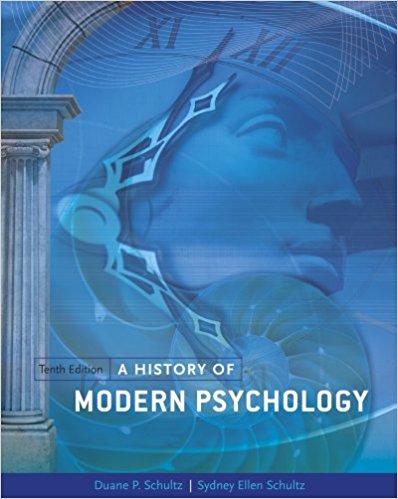Description
Test Bank For History of Modern Psychology 10th Edition Schultz
Chapter_3 Physiological influences on Psychology
|
1. Describe the circumstances under which Bessel discovered the importance of the human observer. To what two conclusions did his findings lead? What were the consequences of his work in terms of subsequent developments in early physiology? ANSWER: Answer not provided. POINTS: 1 NOTES: WWW |
|
2. Describe Müller’s doctrine of the specific energies of nerves. Why was it so important to the early years of modern psychology? ANSWER: Answer not provided. POINTS: 1 |
|
3. Identify the early physiologists who made substantial contributions to the mapping of brain functions and describe the methods and findings of each. ANSWER: Answer not provided. POINTS: 1 |
|
4. Why did experimental psychology begin in Germany rather than in other European countries? ANSWER: Answer not provided. POINTS: 1 NOTES: WWW |
|
5. What contributions led to the description of Helmholtz as “one of the greatest scientists of the 19th century”? ANSWER: Answer not provided. POINTS: 1 |
|
6. Describe the research and findings of Ernst Weber. What was the importance of his work on later physiologists? What was its importance to the new psychology? ANSWER: Answer not provided. POINTS: 1 |
|
7. Discuss why Fechner’s work may have been the necessary precondition for the founding of psychology as a separate discipline. ANSWER: Answer not provided. POINTS: 1 |
|
8. Why was David Kinnebrook fired? a. He dated, but did not marry, the daughter of his boss. b. His observations differed from the observations of his boss. c. He was incompetent. d. He was never able to learn to use the equipment correctly. e. None of the choices are correct. ANSWER: b POINTS: 1 REFERENCES: David K. Makes a Mistake: The Importance of the Human Observer |
|
9. Bessel began the study of individual differences in perception by noting that ____. a. humans differ in the speed with which they react to a loud sound b. animals, such as dogs, have a wider range for hearing sounds than do humans c. time space must be measured in relative units d. astronomers differed in their time estimates in measuring the transit of a star e. None of the choices are correct. ANSWER: d POINTS: 1 REFERENCES: David K. Makes a Mistake: The Importance of the Human Observer |
|
10. Whose research would support the argument that there is no such thing as objective observation? a. Maskelyne’s b. Bessel’s c. Locke’s d. Muller’s e. Wundt’s ANSWER: b POINTS: 1 REFERENCES: David K. Makes a Mistake: The Importance of the Human Observer |
|
11. Bessel’s discovery had an impact on which of the following sciences? a. Psychology b. Physiology c. Biology d. Astronomy e. All of the above ANSWER: e POINTS: 1 REFERENCES: David K. Makes a Mistake: The Importance of the Human Observer |
|
12. Until the work of ____, experimentation was not the preferred method in physiology. a. Galileo b. Newton c. J. Müller d. Broca e. Wundt ANSWER: c POINTS: 1 REFERENCES: Developments in Early Physiology NOTES: WWW |
|
13. Johannes Müller found that nerves only give information characteristic of the sense associated with it. This means that when an auditory nerve is stimulated, it will result in someone hearing a sound, even when no noise is present. Müller called this ____. a. the doctrine of the specific energies of nerves b. specificity c. neuronal tubule clarity d. the postmortem method e. the experimental method in physiology ANSWER: a POINTS: 1 REFERENCES: Developments in Early Physiology |
|
14. Johannes Müller’s most influential publications was ____. a. The Nervous system of Animals b. The Senses c. The Handbook of the Physiology of Mankind d. Experimental Methods e. Interpretation of Dreams ANSWER: c POINTS: 1 REFERENCES: Developments in Early Physiology |
|
15. The practice of psychosurgery such as prefrontal lobotomies, has its roots in the ____. a. implementation of the experimental method in physiology b. doctrine of the specific energies of nerves c. electrical stimulation method d. postmortem method e. extirpation method ANSWER: e POINTS: 1 REFERENCES: Developments in Early Physiology |
|
16. ____ was a pioneer in research on reflex behavior showing that reflexes could occur in the absence of brain involvement. a. Hall b. Broca c. Flourens d. Galvani e. Gall ANSWER: a POINTS: 1 REFERENCES: Developments in Early Physiology |
|
17. In his research, Flourens localized specific functions to how many brain areas? a. 2 b. 3 c. 4 d. 5 e. 6 ANSWER: c POINTS: 1 REFERENCES: Developments in Early Physiology NOTES: WWW |
|
18. “Acts like a chicken with its head cut off” is a description of behavior that has its roots in ____ research. a. Hall’s b. Flouren’s c. Broca’s d. Fritsch’s e. Helmholtz’s ANSWER: a POINTS: 1 REFERENCES: Developments in Early Physiology |
|
19. In modern medicine, the cause of a person’s dementia typically cannot be determined until autopsy. Thus, ____ clinical research method continues to be of significance in medicine and psychology. a. Marshall’s b. Flouren’s c. Broca’s d. Fritsch’s e. Helmhotz’s ANSWER: c POINTS: 1 REFERENCES: Developments in Early Physiology |
|
20. The ____ method is described as a type of posthumous extirpation. a. experimental b. clinical c. scientific d. electrical stimulation e. introspection ANSWER: b POINTS: 1 REFERENCES: Developments in Early Physiology |
|
21. Electrical stimulation as a method of mapping the cerebral cortex was introduced by ____. a. Galvani and Aldini b. Flourens and Hall c. Gall and Spurzheim d. Broca and Kinnebrook e. Fritsch and Hitzig ANSWER: e POINTS: 1 REFERENCES: Developments in Early Physiology |





Be the first to review “Test Bank For History of Modern Psychology 10th Edition Schultz”